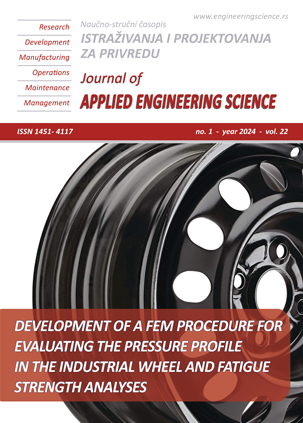EFFECT OF SERVICE LINE ON THE AVERAGE ENERGY CONSUMPTION OF WATER SUPPLY PUMPING STATION
Abstract
The pumps of high lift station consume a high magnitude of power to deliver the water supply to the community consumers, therefore it necessary to looking for means that help to reduce this consumption. The service pipe is an important part of water supply network but it is usually ignored in network analysis. The research focuses on the investigating the effects of this pipe on annual power consumption of pump station. The proposed model is constructed using EPAnet software and different values of diameter and C-coefficient are studied. Moreover, the effect of demand allocation is also studied. The results indicated that the increasing in diameter or in C-coefficient cause decreasing of annual power consumption. The application of demand allocation gives power consumption values less than that for no demand allocation application case. The statistical model showed the significance relationship among power consumption and service pipe properties, and showed that the effect of C-coefficient is higher than the effect of diameter.
References
Mallios Z, Siarkos I., Karagiannopoulos P. and Tsiarapas A., (2022). Pumping energy consumption inimization through simulation-optimization modelling. Journal of Hydrology, vol. 612, p.128062.
Chen W., Tao T., Zhou A., Zhang L., Liao L., Wu X., Yang K., Li C., Zhang T. C. and Li Z., (2021). Genetic optimization toward operation of water intake-supply pump stations system. Journal of Cleaner Production, vol. 279, p.123573.
Omaha NE, (2001). Handbook of public water system, 2nd edition, John Wiley and Sons.
Zhou Y., Lee E. W., Wong L.T. and Mui K. W., (2021). Environmental evaluation of pump replacement period in water supply systems of buildings. Journal of Building Engineering, vol. 40, p.102750.
Cheung C. T., Mui K. W. and Wong L. T., (2013). Energy efficiency of elevated water supply tanks for high-rise buildings. Applied energy, volo. 103, pp.685-691.
Patelis M., Kanakoudis V. and Gonelas K., (2017). Combining pressure management and energy recovery benefits in a water distribution system installing PATs. Journal of Water Supply: Research and Technology—AQUA, vol. 66, no. 7, pp.520-527.
Ramos H. M., Vieira F.and Covas D. I., (2010). Energy efficiency in a water supply system: Energy consumption and CO2 emission. Water Science and Engineering, vol.3, no 3, pp.331-340.
American Water Works Association, (2010). Water Transmission and Distribution, 4th edition, American Water Works Association.
Houghtalen R. J., Akan A. O., and Hwang H. C., (2010). Fundamentals of Hydraulic Engineering Systems, 4th edition, Prentice hall.
Brandt M. J., Johnson K. M., Elphinston A. J. and Ratnayaka D. D., (2017). Twort's water supply, 7th edition, Butterworth-Heinemann.
Davis M. L., (2010). Water and wastewater engineering: design principles and practice. McGraw-Hill Companies.
McGhee T. J. and Steel E. W., (1991). Water supply and sewerage, New York: McGraw-Hill.
Al-Tamir M. A., (2019). The Situation Of Water Treatment Plant In Mosul City, Al-Rafidain Engineering Journal, vol. 24, pp. 138-145.(In Arabic).
Hammer M. J., (2008). Water and wastewater technology. Prentice hall.
Rossman L. A., (2000). EPAnet User Manual, Environmental Protection Agency.
Cengel Y and Cimbala J., (2014). Fluid Mechanics Fundamentals and Applications, 4th edition, McGraw Hill.
Swamee P. K. and Sharma A. K., (2008). Design of water supply pipe networks, John Wiley & Sons.

